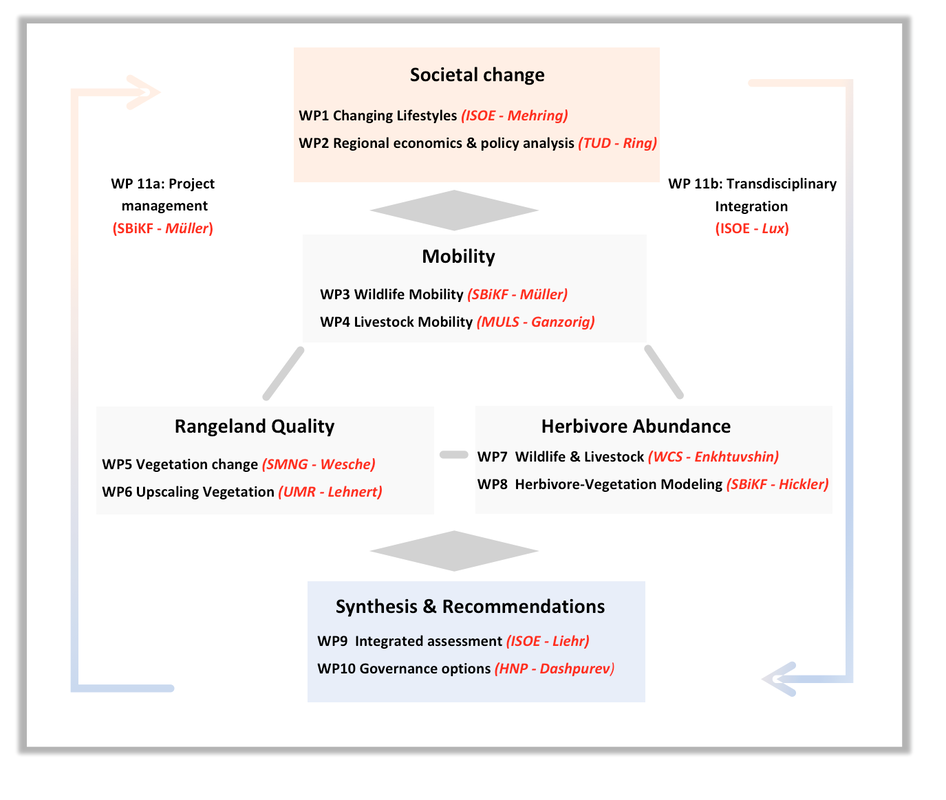The project MORE STEP is divided into 5 modules and 11 work packages (WPs) that analyze different aspects of the social-ecological system of the Mongolian Eastern Steppe. The cross-module and interdisciplinary cooperation of the research groups involved in MORE STEP as well as the transdisciplinary involvement of social, political and industrial interest groups within the modules form the basis for integrative socio-ecological analyzes as well as the creation of a common interdisciplinary research database. Below are the modules of MORE STEP and the research groups involved:
Module 1: Societal change
|
WP1 Changing Lifestyles: This part of the project explores social processes and interactions that influence the tipping point of the Mongolian steppe ecosystem. To this end, the background of land-town migration, traditional ecological knowledge as well as the relationship of the population to the nature are examined using e.g. interviews with the local population.
|
WP2 Regional Economics and Policy Analysis: This part of the project aims to understand regional socio-economic processes and to identify and review existing policy options, governance mechanisms and policy instruments.
|
Module 2: Mobility
|
WP3 Wildlife Mobility: This part of the project investigates the effects of land use change and landscape fragmentation on migratory behavior of wild herbivores. For this purpose, Mongolian gazelles are equipped with GPS transmitters and their movement patterns are analyzed and modeled.
|
WP4 Herder Mobility: In this subproject, the mobility of local herder nomads and their economic decision-making processes are investigated. In addition, the movement behavior of their livestock is examined. Both quantitative social science methods and GPS-based analyzes are used.
|
Module 3: Rangeland Quality
|
WP5 Vegetation Change: This part of the project involves the study of vegetation biomass through field investigations and sampling. It examines the role and impact of vegetation as an ecosystem service provider and its interaction with grazing herbivores, and records soil conditions, forage quality and quantity.
|
WP6 Upscaling Vegetation: Here satellite-based remote sensing data is used to complement the data obtained in field surveys. The satellite imagery created here enables the recording of vegetation degradation as well as the creation of degradation indicators for the entire study region.
|
Module 4: Herbivore Abundance
|
WP7 Wildlife and Livestock Abundance: In this subproject, the status of local wild animal populations and their relationship to anthropogenic landscape change and livestock herding will be examined. Among other things, field investigations and statistical modeling are used.
|
WP8 Herbivore Vegetation Modeling: In this part of the project, mechanistic models are developed to understand the relationships between vegetation, climate and grazing and to develop future projections of herbivore vegetation dynamics.
|
Module 5: Synthesis and Recommendations
|
WP9 Integrated Assessment: This subproject is responsible for the interdisciplinary analysis of the results of the other modules and the creation of an integrative database. This serves the development of integrative socio-ecological models, indicators of the state of the socio-ecological system as well as alternative existence strategies for the local herders.
|
WP10 Gouvernance Options: Here, with the involvement of social, political and industrial stakeholders, management measures and future policy options for the protection of the Mongolian steppe ecosystem are developed.
|
WP11a Project Management
This part of the project serves to scientifically coordinate the research and field work teams as well as the communication of project results to the public, politics and science.
|
WP11b Transdisciplinary Integration
This part of the project will involve stakeholder engagement and information exchange, both between stakeholders and research teams, and within the project.
|
